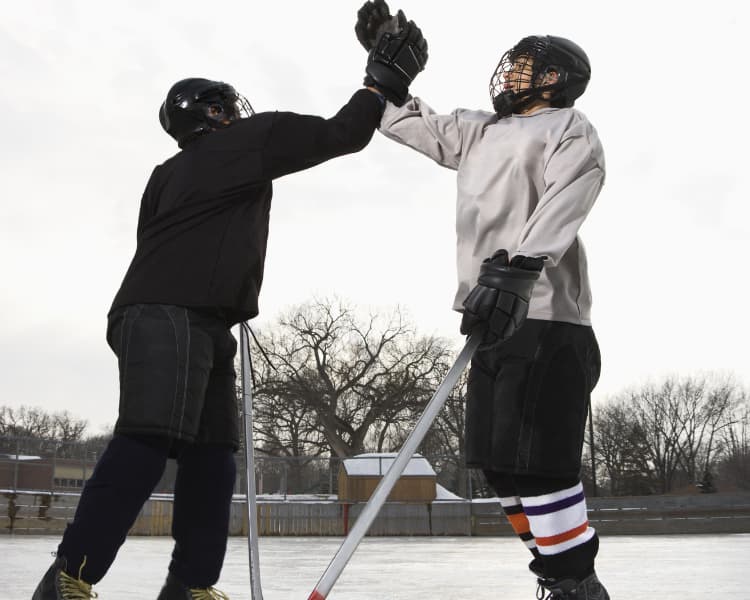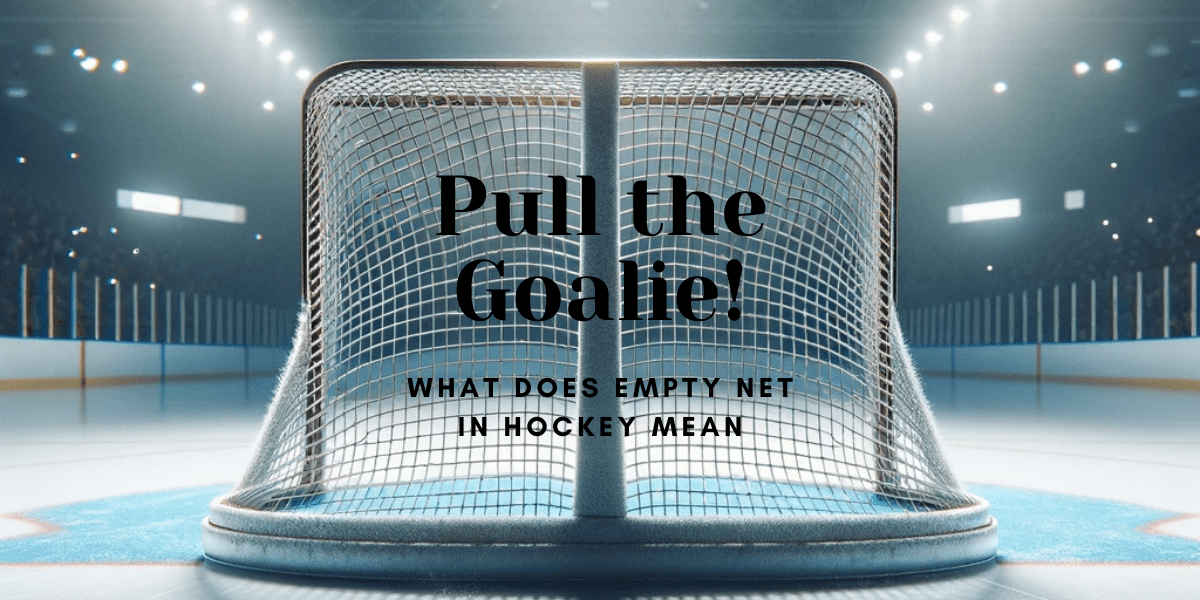What Does Empty Net in Hockey Mean?
Hey there, hockey fans! Today, I’m going to dive into the mysterious world of empty nets in hockey. If you’ve ever found yourself wondering, “What does empty net in hockey mean?” or “Why do they pull the goalie?”, then this is the article for you!
An empty net in hockey is a concept that adds an extra layer of excitement to the game. It’s when the opposing team’s goalie is pulled, leaving the net wide open and giving the attacking team an extra skater advantage. This strategic move can make or break a game, and understanding its ins and outs is key to appreciating the strategic genius behind it.
No need to worry if you’re not familiar with the term “empty net” or how it impacts the game. Throughout this article, I’ll break it down for you, exploring its definition, its strategic implications, and its impact on the dynamics of the game. By the end, you’ll be able to hold your own in any hockey conversation,
Key Takeaways:
- The empty net in hockey refers to when the goalie is pulled, giving the attacking team an extra skater advantage.
- This strategic move is used when a team is trailing by one or two goals late in the game.
- Pulling the goalie increases offensive pressure but also poses risks.
- Factors like the score, time remaining, and team capabilities play a role in deciding when to pull the goalie.
- The empty net play impacts the dynamics of the game and requires strategic adjustments from both teams.
The Strategic Play: What Does Empty Net in Hockey Mean?

Empty net in hockey is a strategic move used by teams when they are trailing by one or two goals late in the game. By pulling their goalie and adding an extra attacker, the team aims to increase their offensive pressure and create scoring opportunities.
However, this move also poses risks and requires careful assessment of the game situation.
In this section, we will explore the various aspects of the strategic play of empty net in hockey and how it affects the dynamics of the game.
When is the Right Time to Pull the Goalie?
Knowing when to pull the goalie is crucial for teams looking to take advantage of the empty net situation. It’s a strategic decision that can greatly impact the outcome of the game.
To determine the right time to pull the goalie, teams assess various factors and evaluate the risks and rewards involved.
Assessing the Situation: Score and Time Remaining
One important factor to consider when deciding to pull the goalie is the score.
Teams are more likely to pull the goalie when they are trailing by one or two goals in the late stages of the game.
The aim is to increase offensive pressure and create scoring opportunities in order to tie the game or take the lead.
The time remaining in the game also plays a crucial role in this decision.

Teams are more likely to pull the goalie when there is enough time left to mount a comeback. Typically, this occurs in the final minute or two of the game, depending on the specific circumstances.
Risk vs. Reward: Managing the Hockey Empty Net Goal Threat
Pulling the goalie comes with inherent risks.
By removing the goaltender, the team exposes their own net, making it vulnerable to the opposing team’s scoring chances.
However, the potential rewards can outweigh the risks. An extra attacker on the ice increases the team’s offensive capabilities, creating more scoring opportunities and putting additional pressure on the opposing defense.
Teams must carefully weigh the potential rewards of pulling the goalie against the risks of giving up an empty net goal.
This delicate balance requires a thorough assessment of the game situation and the team’s offensive prowess.
Team’s Net: Gauging Defensive Strength
Another crucial consideration is the team’s defensive strength. Before pulling the goalie, teams need to evaluate their ability to withstand the opposing team’s offensive pressure.
If the team has shown solid defensive skills throughout the game and has confidence in their ability to protect the net, they may be more inclined to take the risk of pulling the goalie.
Conversely, if the team’s defense has been porous or if there are concerns about their ability to fend off the opposing team’s attacks, they may opt to keep the goalie in the net, prioritizing protecting their own goal rather than risking an empty net goal against.
By carefully considering these factors and weighing the potential risks and rewards, teams can make informed decisions regarding when to pull the goalie. Each game situation is unique, and the timing of this strategic move can have a significant impact on the outcome of the game.
Impact on Game Dynamics and Player Roles

The empty net play in hockey has a profound impact on the dynamics of the game and the roles of players on both teams.
When a team pulls their goalie, they gain an extra attacker on the ice, creating a power play situation.
This presents an opportunity for the attacking team to maximize scoring chances and potentially turn the game in their favor.
Power Play and Extra Attacker: Maximizing Scoring Opportunities
With the advantage of an extra attacker during the power play, the attacking team aims to put maximum pressure on the opposing team’s defense.
They deploy strategies to create passing lanes, set up plays, and unleash powerful shots towards the net.
The objective is to capitalize on the numerical advantage and increase the likelihood of scoring goals.
During the power play, players must demonstrate both skill and creativity to create scoring opportunities.
They utilize quick puck movement, precise passing, and effective positioning to outmaneuver the opposing team’s defense and create open shooting lanes.
Additionally, players who excel at scoring goals are often the focal point of the power play strategy, utilizing their shooting prowess to deliver accurate and powerful shots toward the net.
Defensive Strategy: Opposing Team’s Countermeasures
When facing a power play situation with the opposing team having an extra attacker, the defensive team must adjust its strategy to neutralize the attacking team’s advantage.
They employ various defensive tactics aimed at disrupting passing lanes, blocking shots, and limiting scoring opportunities.
The defensive team often adopts a more compact formation, prioritizing shot blocking and aggressively pressuring the attacking players.
They aim to force turnovers, intercept passes, and clear the puck out of their defensive zone to minimize potential threats to their net.

The goaltender becomes the last line of defense, relying on their positioning and reflexes to make critical saves and deny the attacking team from scoring.
The delayed penalty rule adds another layer of complexity to the defensive strategies employed by the opposing team.
In this scenario, the attacking team can continue to possess the puck without the risk of the play being stopped by an offside or a touch-up.
This gives them an extended opportunity to set up plays, further increasing the defensive challenges for the opposing team.
Overall, the impact of the empty net play on the game dynamics and player roles is significant. It brings excitement, suspense, and strategic battles between the attacking and defending teams.
Whether it’s the power play and the extra attacker maximizing scoring opportunities or the opposing team employing defensive strategies to counter their opponent’s advantage, the empty net play adds an intriguing dimension to the game of hockey.
Historic Moments and Memorable Empty-Netters
When it comes to empty net situations in hockey, there have been countless historic moments and unforgettable goals that have left fans in awe.
From game-changing plays to jaw-dropping displays of skill, these empty-netters have added an extra layer of excitement to the game.
One memorable moment took place during the 1994 Stanley Cup Playoffs, when Wayne Gretzky, known as one of the greatest offensive players in history, scored an empty-net goal in a crucial playoff game.
This goal not only secured the victory for the New York Rangers but also cemented Gretzky’s reputation as a clutch performer in high-pressure situations.
In another iconic moment, Mario Lemieux, a legendary figure in the world of hockey, showcased his incredible skills with a remarkable empty-net goal.
With the opposing team’s net wide open, Lemieux skillfully maneuvered his way past defenders, effortlessly scoring and solidifying his place in hockey history.
It’s not just the superstars who have left their mark with memorable empty-netters. Throughout the years, lesser-known players have also made significant contributions.
These moments serve as a reminder that in hockey, any player can rise to the occasion and make a game-changing play.
The number of goals scored in empty net situations is a testament to the impact of this strategic maneuver.
Teams are willing to take risks and pull their goalie to gain an advantage and secure a crucial victory.
Whether it’s the final goal of a blowout or a game-winning empty-netter, these goals have a special place in the hearts of fans and the annals of hockey history.
Conclusion
And there you have it! We’ve delved into the exciting world of empty net in hockey and uncovered its strategic implications and impact on the game.
Understanding when to pull the goalie, examining the factors that teams consider, and exploring the dynamics of the game during this thrilling situation all shed light on the intricacies of empty net play.
By gaining a deeper appreciation for the strategic aspects of the game, fans can truly grasp the excitement and tension that arises when an empty net situation arises.
It’s not just about the number of goals scored or the offensive player’s skill; it’s about the calculated risks and rewards, the chess-like moves made on the ice, and the nail-biting moments that keep us on the edge of our seats.
So, the next time you witness a team pulling their goalie, remember the strategic considerations at play.
The score, the time remaining, and the team’s offensive and defensive capabilities all contribute to the decision-making process.
It’s a high-stakes maneuver that can change the course of a game and leave lasting memories for fans and players alike.
FAQ
What does empty net in hockey mean?
Empty net in hockey refers to a situation where the opposing team’s goalie is pulled, leaving the net empty and giving the attacking team an extra skater advantage.
What is an empty net goal in hockey?
An empty net goal is a goal scored by the team with the extra attacker when the opposing team’s goalie is pulled, leaving the net unguarded.
When is the right time to pull the goalie in hockey?
The decision to pull the goalie depends on various factors, including the score, time remaining in the game, and the team’s offensive and defensive capabilities. It is typically done when a team is trailing by one or two goals and wants to increase their scoring chances.
How does an empty net goal affect the dynamics of the game?
An empty net goal can have a significant impact on the game, as it often seals the victory for the team that scores it. It increases the winning team’s lead or brings the game to a tie, forcing overtime or a shootout.
Can the team with the empty net score a goal?
Yes, the team with the empty net can still score a goal if they regain possession of the puck and have a scoring opportunity. However, this rarely happens, as the opposing team’s players are typically focused on defending and preventing the empty net goal.
Are there any risks to pulling the goalie and having an empty net?
Yes, there are risks involved in pulling the goalie. If the opposing team gains possession of the puck, they have a clear path to the empty net and can score an easy goal. Additionally, pulling the goalie reduces the team’s defensive presence and makes it easier for the opposing team to create scoring opportunities.



